- Offensive Techniques & Strategies

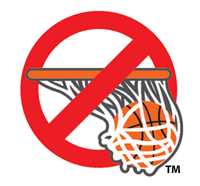
The Case for the Defense
For any defense that is not well prepared in defending a hard hitting inside game, the Base Cross offense will be very difficult to stop. In addition, quick ball reversal down screens pose additional problems for the defense.
Defensive Fundamentals Required
Base Cross Offense Schematic Sequence

Defensive Strategies & Techniques Used To
Combat the Base Cross Offense


Basic NBA Show & Recover
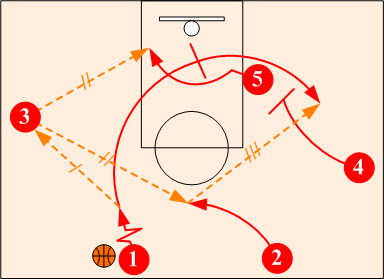
Since the Base Cross Offense involves a "Big" screening against a "Little," most teams do not like to switch. As the "Little" goes across the lane to set a base screen, his defender will step out (shows) and physically blocks the offensive post's path.
Forcing the post high and wide not allows time for the post's defender to fight over the screen and re-establish a defensive position, it also forces the offensive post out away from the low block area. The weakside defenders will also "pack in" (drop) to contest the basket area.
Phase 1: Showing
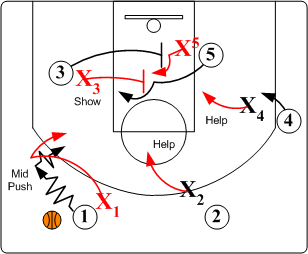
Defensive player X1 forces the point guard O1 to middle and pressures pass to post O5 . Defensive player X2 steps out hard (SHOWS), and forcing O5 to come wide off O2's base screen. X5 trails over the screen assuming 3/4 side or FRONT position against O5. X3 and X4 drop into weakside help position to congest the post areas.
Phase 2: Recover
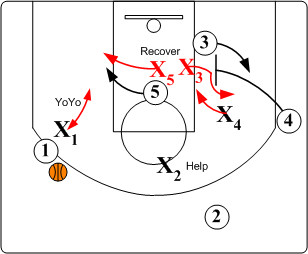
Defensive player X5 plays O5 straight up attempting to force O5 away from the basket and into a turn around jump shot. Weakside defenders X2, X3, and X4 pack it in (help) in attempt to help out on O5. When O1 passes to post O5, O1 can "Yo-Yo" back and forth attempting to help out on O5. When O5 passes back to O1 spotting up, X1 recovers back to O1.
Phase 3: Final Match Up
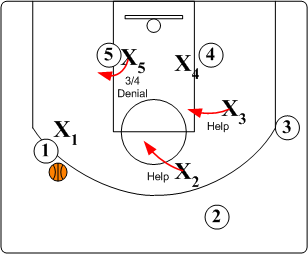
Matching up after the base screen screen, defender X1 applies ball pressure and smothers O1. X5 assumes a defensive post position against O5, pushing O5 off the block. X2, X3, and X4 "Pack It In" on the weakside.

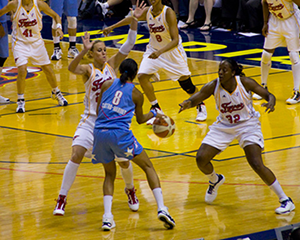
All Out "SOS" Disruption
Disruption of the Base Cross Screen offense is achieved by trapping the ball handler on wing before an entry pass can be made into the post. The base screen action is countered with a "Hi-Lo Switch". If the post goes baseline (low) off the screen, the defenders switch; when the post goes over the top ( high) of the screen, the defenders do not switch.
Should the ball be enter into the post, post trap rotations occur. On the pass out of the trap, near player rotations take place and basic team SOS concepts are in effect.
Phase 1: Double Team (Trap)
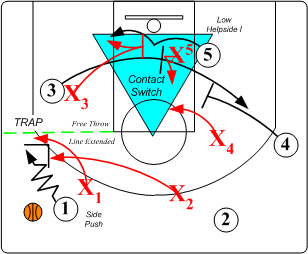
Sideline Trap. Defensive player X1 pushes the point guard O1 to sideline checkpoint. Defensive player X2 traps O1 with X1 above the free throw line extended. X3, after executing a contact pivot switch with X5, Fronts the post O5. X5 forces O5 low along the baseline,and then makes a contact switch with X3. X4 and X5 assume Helpside Triangle "I" positions ready to rotate to O2 or O3 on O1's pass.
Note: If O5 is allowed to go over the top of O3's base screen, there is no switch involved. X5 fronts O5 and X3 assumes the Low Helpside "I" position. This is called a "Hi-Lo Switch." (cutter goes low - switch, cutter goes high - no switch).
Phase 2: Pass Out of Trap
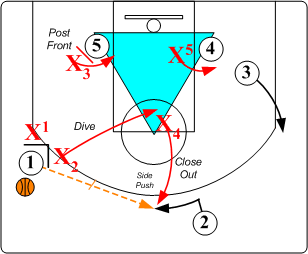
When O1 passes to O2, X4 closes out to O2, pushing O2 toward sideline checkpoint while X1 denies a return pass back to O1. X2 sprint releases to a Mid Helpside "I" position ready to close out to O3 when O2 passes O3 the ball. X3 and X5 assumes a pass denial positions against O5 and O4.
Note: All rotations must take place as ball leaves passer's hands.
Phase 3: Final Match Ups
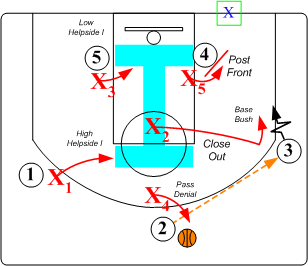
When O2 makes a pass to O3 on wing, X2 closes out to O3 pushing O3 to corner checkpoint. X5 fronts the post O4 while X1 and X3 drop into Helpside "I" positions against O1 and O5. X4 assumes a pass denial position against O2 creating box pressure by preventing the ball reversal pass. When matched up, basic SOS defensive principles are in effect.
© 2026 HoopTactics All Rights Reserved.

